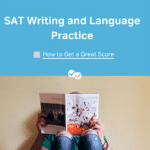What You Need to Know About New SAT Writing
- It’s made up of four 350-450-word essays, containing eleven questions each
- It tests basic grammar
- It also tests more big-picture grammatical issues, i.e. transitions between sentences and transitions between paragraphs
- It tests style, tone, and syntax
- One passage will have a graph with one question
How the College Board Tests Grammar
Over the years, I’ve had several students who would always surprise me when it came to grammar. While masters at gaming the grammar section of the old SAT, they failed to spot even simple grammatical errors in their own essays. But it wasn’t just on the level of struggling to find a subject-verb agreement issue in their own writings. They seemed to miss the larger connections—those between sentences in a paragraph and those between the paragraphs themselves.
I’m guessing that The College Board recognized the same shortcomings in their approach (okay, let’s be honest, the ACT recognized the shortcomings in such an approach). So instead of having isolated snippets of grammar, grammar that becomes very predictable if you know what to look for and thus doesn’t really determine grammar knowledge, the SAT is having students make corrections to a full-length essay.
This change is highly welcome (at least to educators who want the test to actually measure what it purports to). However, it makes the test less easy to game. You’ll actually have to be a decent writer—one who can tell an okay transition sentence from a felicitous one—to do well. That doesn’t mean there aren’t some basic techniques to help you become better at this section.
To Read or Not to Read
400 words are a lot to read. Multiply that by 4 and this section suddenly has 1,600 words—that’s not including the 44 questions. So should you read the entire essay?
I don’t think there is an easy answer. My recommendation is to experiment. First off, time yourself where you do one passage followed by the eleven questions. See how many you get correct and also gauge how comfortable you felt with the material as you went through it. Next, try the same without reading the passage at all.
My hunch is that the more successful approach might be determined by the specific passage. That is, some passages have more paragraph-centric questions. You might only need to read that paragraph to get the question right, and not have to worry about reading the entire passage from the get-go. Conversely, some passages might ask you to analyze the relation between paragraphs or transitions between paragraphs. Without initially reading the entire passage, you might find yourself scrambling around, trying to figure out what to read. Or you might totally overlook the supporting context and think you got the question right but flub it completely.
New Strategy for SAT Writing
- Step 1: Read a paragraph at a time
- Step 2: Re-read parts of that paragraph if necessary
I believe the best possible approach is to read one paragraph at a time and then do the questions relating to that paragraph. That way you’ll be able to quickly go back and correct the grammar issues you just encountered.
You’ll also be able to more easily identify any conjunction issues that come between sentences without having to read the entire paragraph (though you’ll have to reread the specific sentences relating to that question).
Finally, you’ll be able to better notice the transitions between paragraphs, in case a question asks about that.
Know Your Grammar Rules
(AKA “Standard English Conventions”)
Ultimately, the New SAT Writing test is a test of grammar. So you’ll still have to know the basic rules. What seems fairer about this test is that if you have a pretty strong grasp of a grammatical rule you’ll most likely get the question. Sure, there might be a tricky question or two, in which you’ll have to read the previous sentence to figure out the correct answer, but it won’t be anything like the current SAT. With the current, that is soon-to-be-old test, you can drill subject-verb agreement or pronoun antecedent until your eyeballs pop out; you might likely still miss the dreaded question #29 in the writing section.
Know the Section’s Question Types
The new writing section isn’t all about grammar. You’ll have to understand how ideas are developed over the course of a paragraph (and sometimes the entire essay). The test will ask you whether it should add information, delete a sentence, or move a sentence to a different part of a paragraph.
The first time you see such a question you might be flustered. By practicing these questions and learning what the test is expecting of you, you will have an easier time with this question type. And remember this is a standardized test, so the wrong answers—and the reasons they are wrong—are often consistent over tests. Once you pick up on these patterns, you’ll become better at the question type.
The Importance of Context
It is tempting to approach the new writing section by looking directly at the underlined part and the few words around it, and then coming to a conclusion. This might sometimes not get you in trouble, if the question has to do with a possessives or a straightforward subject-verb agreement question. But when dealing with sentence structure or transitions between sentences, it is always a good idea to read the entire sentence before the underlined part and the entire sentence in which the underlined part is contained.
Sometimes, you will have to choose an answer choice that asks you to consider information from the previous paragraph. (We’ll see such an example in the practice passage at the end.) Often, when this happens, the test writers will reinforce the importance of context. Compare these two:
“Which choice most effectively combines the underlined sentences?”
“In context, which choice best combines the underlined sentences?”
The first prompt will focus on grammatical issues within the two sentences that you have to combine (basically, you don’t need to know the sentences that came before). The second prompt, however, clearly states “in context”. So you better make sure you understand the sentences—and sometimes even the paragraph—that come before the combined sentences the question is asking about.






Leave a Reply